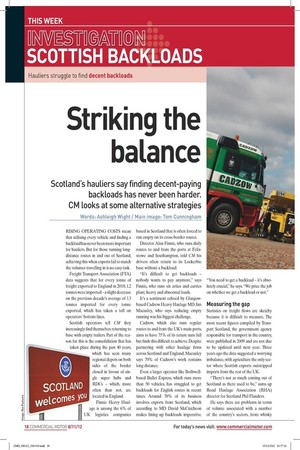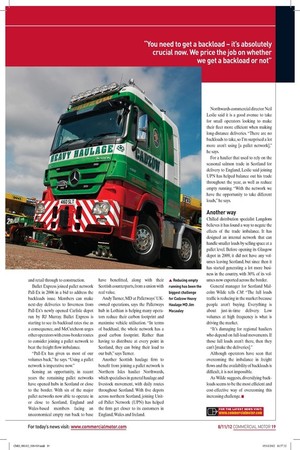Striking the balance
Page 11

Page 12

If you've noticed an error in this article please click here to report it so we can fix it.
Scotland’s hauliers say finding decent-paying backloads has never been harder. CM looks at some alternative strategies
Words: Ashleigh Wight / Main image: Tom Cunningham
RISING OPERATING COSTS mean that utilising every vehicle and finding a backload has never been more important for hauliers. But for those running longdistance routes in and out of Scotland, achieving this when exports fail to match the volumes travelling in is no easy task.
Freight Transport Association (FTA) data suggests that for every tonne of freight exported to England in 2010, 1.2 tonnes were imported – a slight decrease on the previous decade’s average of 1.3 tonnes imported for every tonne exported, which has taken a toll on operators’ bottom lines.
Scottish operators tell CM they increasingly find themselves returning to base with empty trailers. Part of the reason for this is the consolidation that has taken place during the past 40 years, which has seen many regional depots on both sides of the border closed in favour of single super hubs and RDCs – which, more often than not, are located in England.
Finnie Heavy Haulage is among the 6% of UK logistics companies based in Scotland that is often forced to run empty on its cross-border routes.
Director Alan Finnie, who runs daily routes to and from the ports at Felixstowe and Southampton, told CM his drivers often return to its Lockerbie base without a backload.
“It’s difficult to get backloads – nobody wants to pay anymore,” says Finnie, who runs six artics and carries plant, heavy and abnormal loads.
It’s a sentiment echoed by Glasgowbased Cadzow Heavy Haulage MD Jim Macauley, who says reducing empty running was his biggest challenge.
Cadzow, which also runs regular routes to and from the UK’s main ports, aims to have 75% of its return runs full but finds this difficult to achieve. Despite partnering with other haulage firms across Scotland and England, Macauley says 70% of Cadzow’s work remains long distance.
Even a larger operator like Bothwellbased Bullet Express, which runs more than 50 vehicles, has struggled to get backloads for English routes in recent times. Around 70% of its business involves exports from Scotland, which according to MD David McCutcheon makes lining up backloads imperative. “You need to get a backload – it’s absolutely crucial,” he says. “We price the job on whether we get a backload or not.”
Measuring the gap
Statistics on freight flows are sketchy because it is difficult to measure. The most recent figures compiled by Transport Scotland, the government agency responsible for transport in the country, were published in 2009 and are not due to be updated until next year. Three years ago the data suggested a worrying imbalance, with agriculture the only sector where Scottish exports outstripped imports from the rest of the UK.
“There’s not as much coming out of Scotland as there used to be,” sums up Road Haulage Association (RHA) director for Scotland Phil Flanders.
He says there are problems in terms of volume associated with a number of the country’s sectors, from whisky and retail through to construction.
Bullet Express joined pallet network Pall-Ex in 2006 in a bid to address the backloads issue. Members can make next-day deliveries to Inverness from Pall-Ex’s newly opened Carlisle depot run by RJ Murray. Bullet Express is starting to see its backload rates rise as a consequence, and McCutcheon urges other operators with cross-border routes to consider joining a pallet network to beat the freight flow imbalance.
“Pall-Ex has given us most of our volumes back,” he says. “Using a pallet network is imperative now.” Sensing an opportunity, in recent years the remaining pallet networks have opened hubs in Scotland or close to the border. With six of the major pallet networks now able to operate in or close to Scotland, England and Wales-based members facing an uneconomical empty run back to base have benefitted, along with their Scottish counterparts, from a union with real value.
Andy Turner, MD at Palletways’ UKowned operations, says the Palletways hub in Lothian is helping many operators reduce their carbon footprint and maximise vehicle utilisation. “In terms of backhaul, the whole network has a good carbon footprint. Rather than having to distribute at every point in Scotland, they can bring their load to our hub,” says Turner.
Another Scottish haulage firm to benefit from joining a pallet network is Northern Isles haulier Northwards, which specialises in general haulage and livestock movement, with daily routes throughout Scotland. With five depots across northern Scotland, joining United Pallet Network (UPN) has helped the firm get closer to its customers in England, Wales and Ireland. Northwards commercial director Neil Leslie said it is a good avenue to take for small operators looking to make their fleet more efficient when making long-distance deliveries. “There are no backloads to take, so I’m surprised a lot more aren’t using [a pallet network],” he says.
For a haulier that used to rely on the seasonal salmon trade in Scotland for delivery to England, Leslie said joining UPN has helped balance out his trade throughout the year, as well as reduce empty running. “With the network we have the opportunity to take different loads,” he says.
Another way
Chilled distribution specialist Langdons believes it has found a way to negate the effects of the trade imbalance. It has designed an internal network that can handle smaller loads by selling space at a pallet level. Before opening its Glasgow depot in 2009, it did not have any volumes leaving Scotland, but since then it has started generating a lot more business in the country, with 30% of its volumes now exported across the border.
General manager for Scotland Malcolm Wilde tells CM: “The full loads traffic is reducing in the market because people aren’t buying. Everything is about just-in-time delivery. Low volumes at high frequency is what is driving the market.
“It’s damaging for regional hauliers who depend on full-load movements. If those full loads aren’t there, then they can’t [make the deliveries].” Although operators have seen that overcoming the imbalance in freight flows and the availability of backloads is difficult, it is not impossible.
As Wilde suggests, diversifying backloads seems to be the most efficient and cost-effective way of overcoming this increasing challenge. n









































